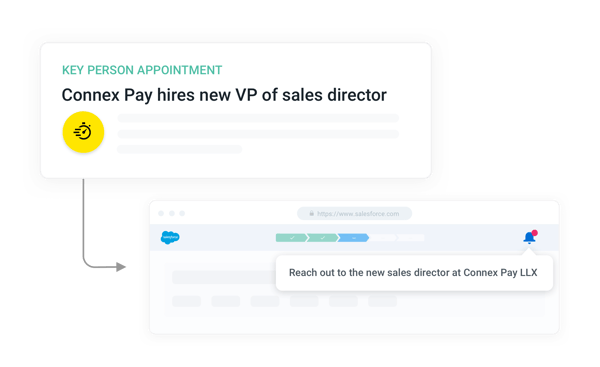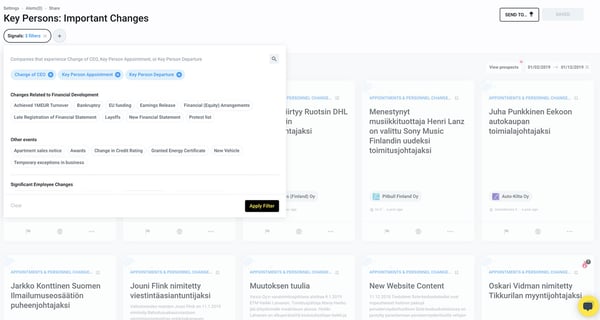How To Use Sales Trigger Events To Find New Sales Opportunities
In sales, being lucky is in your hands. Your expertise, networks, and contacts will boost your luck-o-meter, but when the stars are not aligned—and usually they aren't, tapping into modern technologies and data will undoubtedly increase your chances of closing a deal.
A recently published HubSpot Sales Enablement 2021 Report presents a few not so flattering figures related to sales reps, e.g., 50% of prospects think salespeople are pushy, and only 3% of buyers trust sales reps. Acknowledging this, it comes as no surprise that only 22% of salespeople are very effective at personalizing content for every buyer interaction, according to Forrester. This equation is even more problematic because modern buyers expect an even more relevant, personalized approach than they did a few years ago. Buyers are more knowledgeable when they have their first interaction with you, and they expect you to meet them where they are in the buying journey.
To learn how not to fall into these statistics and find new sales opportunities, continue reading further about the what, why, and how of tracking and acting upon trigger events in outbound sales.
What is a sales trigger event?
Any change in any company data point can act as a trigger event that creates an opening for a sales or marketing opportunity. Trigger events indicate the right time and context to contact a prospect. Company changes triggering actions can be anything that helps you determine which companies are likely to need your offering and when to reach out.
There can be inbound and outbound trigger events. Inbound triggers are mostly set up and tracked with marketing automation. Outbound sales trigger events refer to all kinds of company changes you can imagine: releasing a new product, changes in the company's management, expanding to a new market, a newly registered web domain, or changes in the company's tech stack to mention a few.
Any change in any company data point can act as a trigger event that creates an opening for a sales or marketing opportunity.
Why you should track sales trigger events
It’s dead simple. When you reach out to a prospect based on a trigger event, timing is on your side. You have all the information you need to deliver a tailored offer, and you can be confident that the time is ripe. In other words, you’ll be reaching out to companies that are likely to be looking for your product. Sounds unrealistic? Perhaps, but this can happen, and it will happen if you set rules to luck with the help of modern technology and data. Company information makes you relevant and allows you to tailor your approach. Sales trigger events are a fundamental part of real-time sales because they tell you when to act.
Sales trigger event use cases
Find best-fit prospects
Trigger events provide you with a constant flow of new prospects and help you determine which ones you should prioritize. It will, however, happen only after setting the stage for sales prospecting by defining your ideal customer profile (ICP), including the changes revealing new sales opportunities. Include relevant triggers in your ICP by using data-driven insights to find common themes amongst your best customers. Continue reading, and we'll elaborate on this further. Additionally, tracking company changes help you:
- Find the best prospects and prioritize the right companies. You may have hundreds of companies in your CRM, but triggers help you sort out the ones you should prioritize right now.
- Find the right timing. Anticipating the buyer's needs and reaching out before they begin researching will increase the likelihood of landing the sale first.
- Carry out smarter conversations. You can tailor your pitch based on the prospect's current situation. You'll always have an apparent reason to be in contact, so there's no doubt whether you should reach out right now. How? We'll come into that very soon.
Types of sales trigger events
Any company attribute can be a trigger event. Because businesses are living organisms in flux, any change in those characteristics can be an excellent indicator that there's an opportunity for you.
Here are some common types of sales trigger events.
- Funding
- New hires
- Company relocation
- Company expansion
- Mergers and acquisitions
- Technologies in use
- New products
Choosing the right triggers events to track
So, which trigger events should you be following if any change in any data point can be a trigger? There’s not a single, unique answer. The triggers you choose depend on your sales organization, your offering, and your ICP. Start by looking closer at your existing customers: What happened in their organizations before they became customers? Find a correlation between a happy customer and a specific event, and you can find a heap of actionable leads in the future. Remember to validate your gut feeling with data-driven insights.
Trigger events come in all shapes and forms. Changes triggering action at your end can be, for example, related to changes in the company's management, new hires, expanding the business, mergers or acquisitions, the launch of a new product, company relocations, layoffs, or closed funding rounds. Furthermore, changes in the company's tech stack, newly registered web domains, new financial statements, or changes in hiring volume can open up a possibility for new discussions. Once you’ve selected which company changes you want to be aware of and act upon, you can create a game plan in advance. What will you do when a company goes through a specific change?
Find a correlation between a happy customer and a specific event, and you can find a heap of actionable leads in the future.
How to examine your existing customers
Import a company list into a sales intelligence software like Vainu. What changes occurred in the majority of the companies right before they signed a deal with you, if any?
.gif?width=600&name=ezgif.com-optimize%20(1).gif)
For some companies, a prospect's tech stack can tell you about needs that are seemingly unrelated to technology. For example, at Vainu, we systematically target companies that use modern marketing automation solutions. We've recognized that companies using marketing automation platforms usually try to improve their key performance indicators in the marketing and sales departments. Furthermore, these companies tend to be eager to deploy new technologies. If you're selling services related to logistics, a relevant trigger event for you would probably be a new large contract, for example.
To make your work easier, we've created this free tool (a spreadsheet) on how you can evaluate which trigger events work for you and which you should throw in the bin.
👉You can download the template here.👈
Build a workflow for every trigger event
For each trigger event, you should have a game plan in place. This way, you ensure you can act upon the trigger as soon as possible, without a doubt and hassle. Do this, preferably within 24 hours, and mitigate the risk of losing the sale to your competitor. Document the sales trigger events that are the most relevant to your sales process (i.e., are included in your ICP) along with the sales pitches, and you or your sales reps will know why and how to reach out. To finish the workflow, have the content pieces ready and tailored to a prospect in this specific situation.
 Luckily nowadays, you don't have to spend hours and hours plowing through masses of data on various websites, social media, and newspapers to be up-to-date on the latest changes among your customers and prospects. You can automate this process by tapping into sales intelligence tools like Vainu, designed explicitly for tracking and monitoring any data point. The best thing is that you can get the trigger events delivered automatically to your CRM. Be sure to act quickly whenever a trigger event occurs. Triggers allow you to:
Luckily nowadays, you don't have to spend hours and hours plowing through masses of data on various websites, social media, and newspapers to be up-to-date on the latest changes among your customers and prospects. You can automate this process by tapping into sales intelligence tools like Vainu, designed explicitly for tracking and monitoring any data point. The best thing is that you can get the trigger events delivered automatically to your CRM. Be sure to act quickly whenever a trigger event occurs. Triggers allow you to:
- Initiate marketing campaigns and tailored sales pitches any time a relevant change at a company’s end occurs (for example, a company registers a new web domain).
- Automatically add new accounts to your target lists as soon as they meet certain criteria (for example, your ideal customer profile).
- Keep your databases fresh and updated by tracking any changes in a particular data point in a selected group of companies (for example, your CRM is updated whenever one of your customers relocates its corporate headquarters).
Here's an example of a workflow you can set up in Vainu based on trigger events.
Sales trigger event example: Change in top management
Someone in a key leadership position, e.g., a sales director, has either left the company or a new director is appointed.

Reason to reach out
A person appointed to a leadership position typically wants to leave his/her mark on the organization as quickly as possible. It often means hiring new team members, evaluating existing processes, investing in new ventures, and revamping the strategy to achieve the desired impact.
Sales pitch
Congratulate the person on the new role, and highlight how your services help decision-makers in their first 90 days.
Share content
Share relevant content to be helpful. For example, here's a template we've done based on the discussions we've had with thousands of sales directors to help organizations create their very own sales playbook.
Sky's the limit
As long as you have the right data feeding into your sales process, you can create as many trigger-based workflows as you can imagine. Our Trigger Events template explains in detail how any sales organization can create workflows for the most relevant triggers, thus taking steps towards establishing a real-time sales mindset.
Set your rules for luck and use triggers events to land at the right place at the right time.
Want to know more about how Vainu helps you keep track of company changes? Drop your email here!

